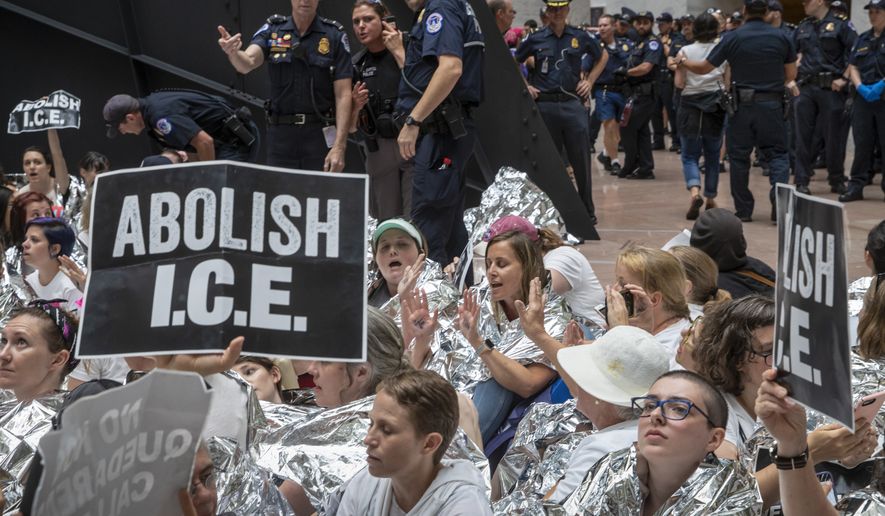The federal government will have to cut corners on safety checks in order to meet a federal judge’s “extreme” deadlines to reunify families separated at the border, Health and Human Services Secretary Alex Azar said Thursday.
None of the children separated has been reunited with an illegal immigrant parent still in government custody, Mr. Azar said, though HHS will meet the court’s deadlines.
The 100 or so children younger than 5 who were separated by government authorities must be reunited by Tuesday. As many as 2,900 other children ages 5 to 17 must be reunited by July 26.
The government has had to turn to DNA testing to confirm relationships with the children, the government said. The goal is to weed out bogus claims by people who aren’t related to the children but are trying to get a hold of them anyway.
Comparing DNA is faster than the usual process of birth certificates and other family documents, but the government won’t be able to complete all of the usual safety checks by the deadline.
“We will comply even if those deadlines prevent us from conducting our standard, or even a truncated vetting process,” Mr. Azar told reporters.
Federal officials said the DNA is being used only for reunification, not for broader tracking or surveillance.
Mr. Azar said he has surged manpower to meet the court orders.
The Office of Refugee Resettlement, the HHS division responsible for caring for unaccompanied alien children, has 11,800 in its dorms and other shelters.
HHS officials have reviewed every single case to determine who might fall under the judge’s order.
Most of the 11,800 are traditional unaccompanied alien children whose parents sent them to the border or who came on their own without any parent. But as many as 3,000 show some indication that they may have been traveling with a parent and could be subject to the order for speedy reunification.
Government background checks already have come across two purported parents with histories of child cruelty, rape or kidnapping, making them unsuitable to take custody of children, Mr. Azar said.
Those are the sorts of cases they are trying to avoid as they perform the DNA and suitability checks. The HHS secretary said the government will have to truncate such checks to meet the judge’s order.
“We have to protect children from people who would prey on them,” he said.
Although illegal immigrant children have dogged the government for years, dating back to the Obama administration, the latest debates have been more pointed because of President Trump’s get-tough policy on the border.
Part of that policy was the zero-tolerance approach to illegal immigrants, announced in early May. Under that policy, Border Patrol agents referred and prosecutors pursued cases on nearly everyone caught jumping the border. Those crossing the border illegally headed to jails for at least a few days.
Prosecutors in previous administrations have pursued illegal immigrants, but rarely families. Smugglers and migrants then began to bring children to take advantage of the family “loophole.”
However, the Trump administration’s decision to pursue charges led to separations of children from their parents because federal jails aren’t able to accommodate families.
After a massive backlash, the administration scuttled its plans and said it would no longer send parents to jail but keep them in immigration detention. That effectively derailed the zero-tolerance policy, at least as it relates to families.
Still, grappling with more than 2,000 children who have been separated already is proving to be difficult.
Mr. Azar said his department usually tries to release children to families already living in communities in the U.S. — often illegal immigrants themselves. He said releasing children back to parents who are still in immigration custody is new to HHS and is proving tricky.
Fed up with delays, a number of groups have asked federal courts to step in.
Last week, a judge in California accepted the invitation, ordering a halt to most separations and setting the deadlines for reunification of children separated from parents.
The American Civil Liberties Union, which is driving that lawsuit, said the administration is playing a “blame game” with the courts rather than working to get families back together.
“When the government wants to marshal its resources to separate families, it has shown that it can do it quickly and efficiently, but when told to reunite families, it somehow finds it too difficult and cumbersome to accomplish,” said Lee Gelernt, deputy director of the ACLU’s national Immigrants’ Rights Project.
Mr. Gelernt and the federal Justice Department are due to give updates to the court Friday about progress in meeting the deadlines.
• Stephen Dinan can be reached at sdinan@washingtontimes.com.




Please read our comment policy before commenting.